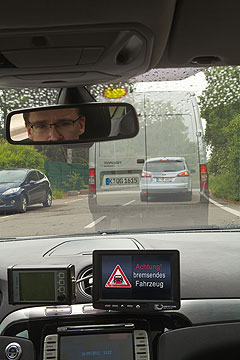Make / Model Search
News - FordNew technology hits the roadLook who’s talking: C2X technology will link cars and infrastructure to improve safety and traffic movement. Future ‘car-to-X’ communications technologies go on trial in Europe7 Aug 2012 AN innovative emergency brake warning developed by Ford is among a number of future technologies that began real-world testing in Europe this week. The new technologies, developed by all six major German car-makers, are designed to improve safety and traffic management by advancing car-to-X (C2X) – which includes car-to-car (C2C) and car-to-infrastructure (C2I) – communications. News of the tests comes just one week after General Motors announced in the US it is working on a system that would use increasingly advanced smartphones to also identify – and hopefully avoid – pedestrians and cyclists on the roads. The European tests are the culmination of a German government-funded four-year research project called simTD (Safe Intelligent Mobility – Testfield Germany), in which Audi, BMW, Daimler, Ford, Opel and Volkswagen are among the partners. This €53 million ($A62.1m) project, which was initiated in September 2008, is designed to better understand the potential for wireless C2X communication technologies to improve safety and personal mobility by identifying traffic threats before they become a threat, or are even seen.  Left: Ford says its Electronic Brake Light alerts a driver when a vehicle ahead brakes suddenly, even if it cannot be seen. Left: Ford says its Electronic Brake Light alerts a driver when a vehicle ahead brakes suddenly, even if it cannot be seen.All six car-makers have provided 20 vehicles each – Ford is contributing 20 specially equipped Mondeo-based S-Max compact people-movers – and the 120-vehicle fleet will test 20 experimental driver assistance technologies until the end of the year. These new technologies include what Ford describes as its Electronic Brake Light, which alerts a driver when a vehicle ahead brakes suddenly, even if it cannot be seen by the driver, for example when concealed by a large van or in fog. Ford claims it is leading the development and integration of this application. Others future technologies being tested by the simTD consortium are described by Ford as: Obstacle Warning system, which enables a vehicle to inform other road users of the presence, position and type of potentially hazardous obstacles on the road Traffic Sign Assistant, which remains in continuous contact with traffic management centres to access up-to-date information on variable speed limits, temporary restrictions and diversions, as well as providing details of current and approaching permanent regulations, such as fixed speed limits and right of way Public Traffic Management, which provides exact traffic prognosis based on comprehensive information such as identifying likely traffic scenarios and their impact at the point in the journey when they are encountered rather than at the point of departure In-car internet access that can, for example, enable the driver to reserve and pay for parking en-route. Both Daimler and Ford claim to be global leaders in researching C2X communications. Ford initiated a partnership with the Minnesota Transportation Department in the US in 2004 to develop the next generation of transportation and driver information systems, and claims to be the first vehicle manufacturer in the US to demonstrate intelligent vehicle communication technologies to the public, with a multi-city tour that began in 2010. Daimler, which heads the simTD project, cites long-standing involvement in the technology in both the US and Europe, with research project results that have been incorporated into current C2X testing and its standardisation. “We are convinced that C2X communication is going to play an important role in the mobility of the future,” said overall simTD project leader Christian Weiss, the head of cooperating systems at Daimler Research and Advance Development. “C2X communication allows us to detect objects and hazardous situations far beyond the immediate environment of the vehicle. This is a significant step on the path towards accident-free driving.” Ford Research and Innovation chief technical officer and vice-president Paul Mascarenas said the European test fleet would cover thousands of kilometres in test drives and evaluations to gather valuable research data from every-day driving scenarios, having previously tested the developmental technologies only in a controlled environment. “Car-to-car and car-to-infrastructure communications represent the next major advancements in vehicle safety,” he said. “Ford is committed to further real-world testing here and around the world with the goal of implementation in the foreseeable future.” Mr Mascarenas said increasing the use of this technology was part of Ford’s Blueprint for Mobility, a vision for mobility between now and 2025 that was outlined by Ford executive chairman Bill Ford during his keynote address at the 2012 Mobile World Congress in Barcelona in February.  Read more |
Click to shareFord articlesResearch Ford Motor industry news |












Facebook Twitter Instagram